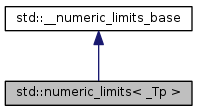std::numeric_limits< _Tp > Struct Template Reference
Inheritance diagram for std::numeric_limits< _Tp >:

Static Public Member Functions
- static constexpr _Tp denorm_min () _GLIBCXX_USE_NOEXCEPT
- static constexpr _Tp epsilon () _GLIBCXX_USE_NOEXCEPT
- static constexpr _Tp infinity () _GLIBCXX_USE_NOEXCEPT
- static constexpr _Tp lowest () noexcept
- static constexpr _Tp max () _GLIBCXX_USE_NOEXCEPT
- static constexpr _Tp min () _GLIBCXX_USE_NOEXCEPT
- static constexpr _Tp quiet_NaN () _GLIBCXX_USE_NOEXCEPT
- static constexpr _Tp round_error () _GLIBCXX_USE_NOEXCEPT
- static constexpr _Tp signaling_NaN () _GLIBCXX_USE_NOEXCEPT
Static Public Attributes
- static constexpr int digits
- static constexpr int digits10
- static constexpr float_denorm_style has_denorm
- static constexpr bool has_denorm_loss
- static constexpr bool has_infinity
- static constexpr bool has_quiet_NaN
- static constexpr bool has_signaling_NaN
- static constexpr bool is_bounded
- static constexpr bool is_exact
- static constexpr bool is_iec559
- static constexpr bool is_integer
- static constexpr bool is_modulo
- static constexpr bool is_signed
- static constexpr bool is_specialized
- static constexpr int max_digits10
- static constexpr int max_exponent
- static constexpr int max_exponent10
- static constexpr int min_exponent
- static constexpr int min_exponent10
- static constexpr int radix
- static constexpr float_round_style round_style
- static constexpr bool tinyness_before
- static constexpr bool traps
Detailed Description
template<typename _Tp>
struct std::numeric_limits< _Tp >
Properties of fundamental types.
This class allows a program to obtain information about the representation of a fundamental type on a given platform. For non-fundamental types, the functions will return 0 and the data members will all be false.
_GLIBCXX_RESOLVE_LIB_DEFECTS: DRs 201 and 184 (hi Gaby!) are noted, but not incorporated in this documented (yet).
Member Function Documentation
template<typename _Tp >
| static constexpr _Tp std::numeric_limits< _Tp >::denorm_min | ( | ) | [inline, static] |
template<typename _Tp >
| static constexpr _Tp std::numeric_limits< _Tp >::epsilon | ( | ) | [inline, static] |
template<typename _Tp >
| static constexpr _Tp std::numeric_limits< _Tp >::infinity | ( | ) | [inline, static] |
template<typename _Tp >
| static constexpr _Tp std::numeric_limits< _Tp >::lowest | ( | ) | [inline, static] |
template<typename _Tp >
| static constexpr _Tp std::numeric_limits< _Tp >::max | ( | ) | [inline, static] |
template<typename _Tp >
| static constexpr _Tp std::numeric_limits< _Tp >::min | ( | ) | [inline, static] |
template<typename _Tp >
| static constexpr _Tp std::numeric_limits< _Tp >::quiet_NaN | ( | ) | [inline, static] |
template<typename _Tp >
| static constexpr _Tp std::numeric_limits< _Tp >::round_error | ( | ) | [inline, static] |
template<typename _Tp >
| static constexpr _Tp std::numeric_limits< _Tp >::signaling_NaN | ( | ) | [inline, static] |
Member Data Documentation
constexpr int std::__numeric_limits_base::digits [static, inherited] |
constexpr int std::__numeric_limits_base::digits10 [static, inherited] |
constexpr float_denorm_style std::__numeric_limits_base::has_denorm [static, inherited] |
See std::float_denorm_style for more information.
constexpr bool std::__numeric_limits_base::has_denorm_loss [static, inherited] |
constexpr bool std::__numeric_limits_base::has_infinity [static, inherited] |
constexpr bool std::__numeric_limits_base::has_quiet_NaN [static, inherited] |
constexpr bool std::__numeric_limits_base::has_signaling_NaN [static, inherited] |
constexpr bool std::__numeric_limits_base::is_bounded [static, inherited] |
constexpr bool std::__numeric_limits_base::is_exact [static, inherited] |
constexpr bool std::__numeric_limits_base::is_iec559 [static, inherited] |
constexpr bool std::__numeric_limits_base::is_integer [static, inherited] |
constexpr bool std::__numeric_limits_base::is_modulo [static, inherited] |
constexpr bool std::__numeric_limits_base::is_signed [static, inherited] |
constexpr bool std::__numeric_limits_base::is_specialized [static, inherited] |
constexpr int std::__numeric_limits_base::max_digits10 [static, inherited] |
constexpr int std::__numeric_limits_base::max_exponent [static, inherited] |
constexpr int std::__numeric_limits_base::max_exponent10 [static, inherited] |
constexpr int std::__numeric_limits_base::min_exponent [static, inherited] |
constexpr int std::__numeric_limits_base::min_exponent10 [static, inherited] |
constexpr int std::__numeric_limits_base::radix [static, inherited] |
constexpr float_round_style std::__numeric_limits_base::round_style [static, inherited] |
See std::float_round_style for more information. This is only meaningful for floating types; integer types will all be round_toward_zero.
constexpr bool std::__numeric_limits_base::tinyness_before [static, inherited] |
constexpr bool std::__numeric_limits_base::traps [static, inherited] |
The documentation for this struct was generated from the following file:
